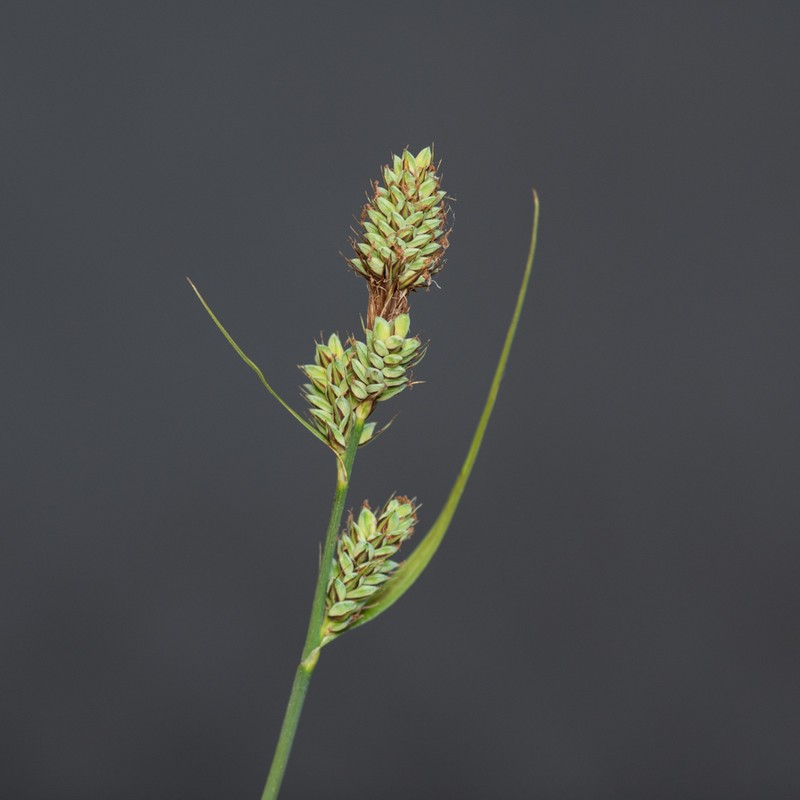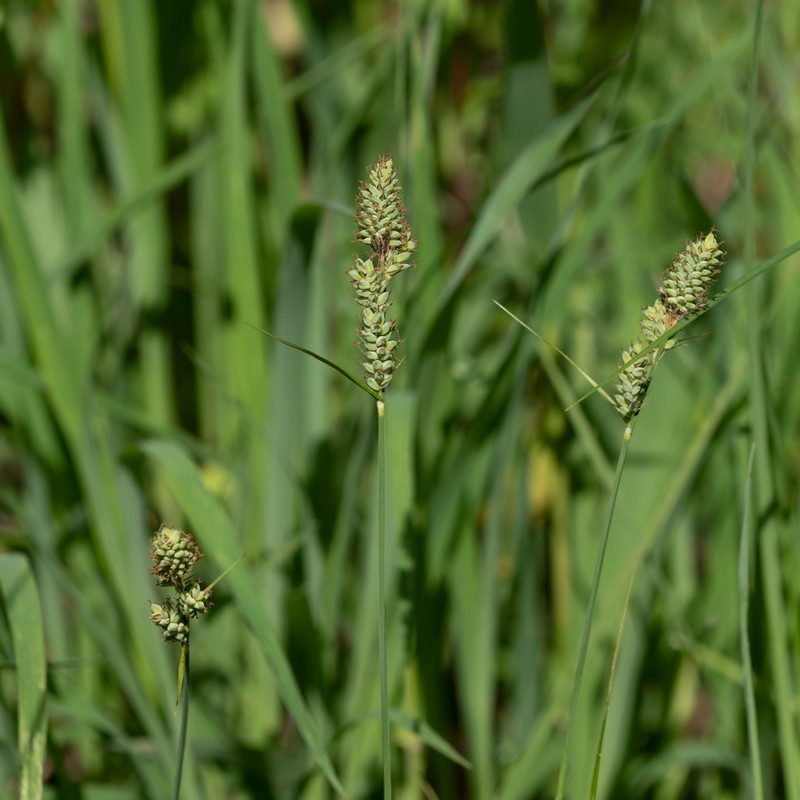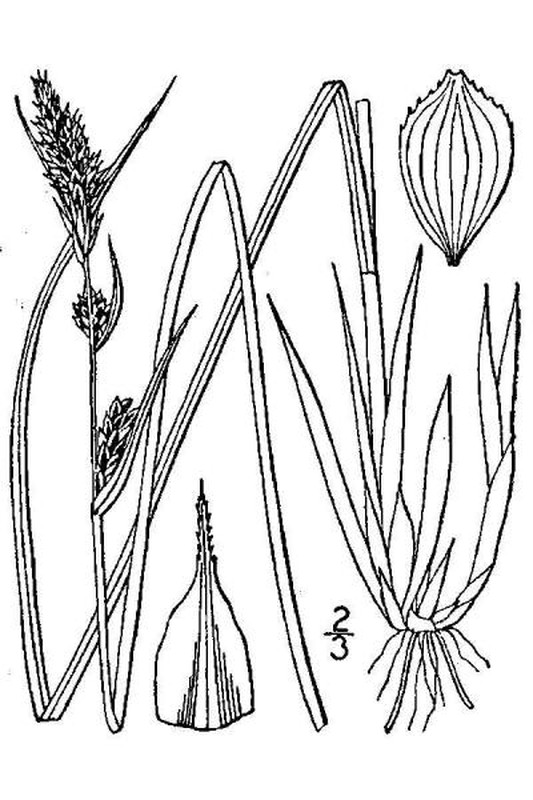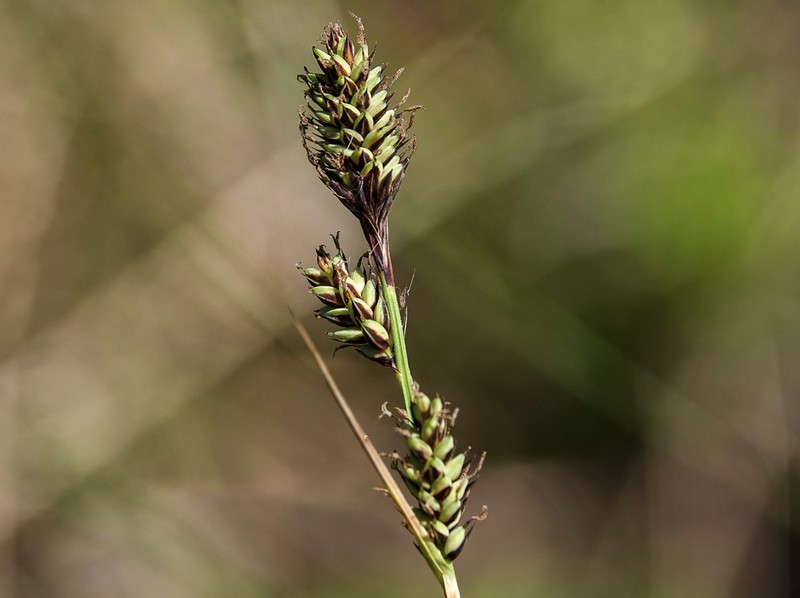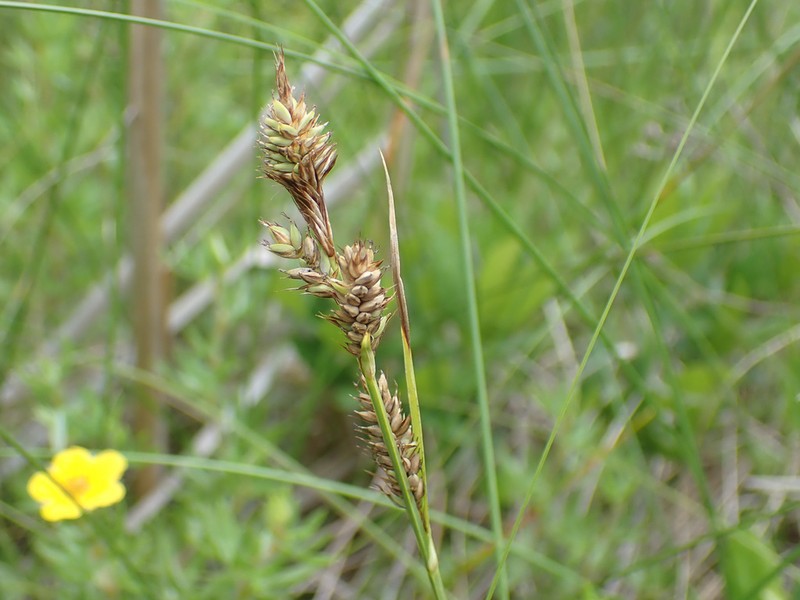Brown Bog Sedge
Carex buxbaumii Wahlenb.
- Class
- Monocotyledoneae (Monocots)
- Family
- Cyperaceae (Sedge Family)
- State Protection
- Threatened
Listed as Threatened by New York State: likely to become Endangered in the foreseeable future. For animals, taking, importation, transportation, or possession is prohibited, except under license or permit. For plants, removal or damage without the consent of the landowner is prohibited.
- Federal Protection
- Not Listed
- State Conservation Status Rank
- S2
Imperiled in New York - Very vulnerable to disappearing from New York due to rarity or other factors; typically 6 to 20 populations or locations in New York, very few individuals, very restricted range, few remaining acres (or miles of stream), and/or steep declines.
- Global Conservation Status Rank
- G5
Secure globally - Common in the world; widespread and abundant (but may be rare in some parts of its range).
Summary
Did you know?
The specific epithet buxbaumii is for Johann Christian Buxbaum who lived from 1693-1730 (Fernald 1970).
State Ranking Justification
There are approximately ten known populations and as many as twenty additional historical locations. These populations are widely scattered throughout the entire state. This plant may be impacted by invasive wetland species. Only one population has over a thousand stems, with typical populations having a few hundred stems. Most of the Long Island historical locations are considered extirpated.
Short-term Trends
There are about 10 populations that have been seen in recent years. Exact trends at these populations is unknown. Most of these populations are not large but appear healthy. There is no reason to suspect that they are declining but there is no data to prove this assertion. Therefore, short term trends are unknown but are suspected of being stable.
Long-term Trends
At least four populations that occurred in the New York City area are believed extirpated. There are at least 20 additional populations that have not been seen in recent years. One of these populations was searched for without success but may still be extant. It is unknown if the other historical populations are still extant. Overall, long term trends are not clear but indicate at least some decline.
Conservation and Management
Threats
Currently there are no threats to populations of Carex buxbaumii but potential threats include development, invasive species, and flooding by beaver.
Conservation Strategies and Management Practices
Invasive species need to be monitored at one population and controlled if negatively impacting the habitat where the C. buxbaumii occurs. One site needs to be monitored for flooding by beavers and flooding needs to be prevented. At least one population needs to be protected from potential adjacent development.
Research Needs
All populations that have not been seen in recent years need to be surveyed to determine if they are still extant.
Habitat
Habitat
Carex buxbaumii occurs in a variety of wet habitats but prefers calcareous sites. It grows in rich fens, swamps, wet meadows, ice scoured river edges, lake shores, and vernal ponds. It is mostly found in relatively small patches (New York Natural Heritage Program 2006). Wet meadows, marshes, and fens (Murray 2002). Peat-bogs, marshes, wet meadows, and other wet places (Gleason and Cronquist 1991). Shores, meadows, marshes, and old bogs, often forming large stands; sometimes in marly bogs and marshes; in crevices and hollows of the rock shore of Lake Superior (Voss 1972). Wet shores, swamps, and bogs (Fernald 1970). Sunny swamps or wet meadows or springy places in calcareous regions (Mackenzie 1931-1935).
Associated Ecological Communities
- Calcareous shoreline outcrop*
(guide)
A community that occurs along the shores of lakes and streams on outcrops of calcareous rocks such as limestone and dolomite. The vegetation is sparse; most plants are rooted in rock crevices.
- Cobble shore*
(guide)
A community that occurs on the well-drained cobble shores of lakes and streams. These shores are usually associated with high-energy waters (such as high-gradient streams), and they are likely to be scoured by floods or winter ice floes.
- Inland calcareous lake shore*
(guide)
The gravelly, sandy, or muddy shore of an inland lake or pond with calcareous water and seasonally fluctuating water levels. There may be few plants and those that are present are usually herbaceous.
- Marl fen*
(guide)
A wetland that occurs on a bed of marl. Marl is a whitish substance that is deposited from water that has a lot of calcium dissolved in it. The whitish substance is calcium carbonate, people used to harvest marl to lime agricultural fields. The marl substrate is always saturated, may be flooded, and has a very high pH, generally greater than 7.5. The main source of water is always groundwater. The plants are often sparse and stunted. Marl fens may occur as small patches within a rich graminoid fen.
- Red maple-tamarack peat swamp
(guide)
A swamp that occurs on organic soils (peat or muck) in poorly drained depressions. These swamps are often spring fed or enriched by seepage of mineral-rich groundwater resulting in a stable water table and continually saturated soil. The dominant trees are red maple and tamarack. These species usually form an open canopy (50 to 70% cover) with numerous small openings dominated by shrubs or sedges.
- Rich graminoid fen
(guide)
A wetland of mostly grasses usually fed by water from highly calcareous springs or seepage. These waters have high concentrations of minerals and high pH values, generally from 6.0 to 7.8. Plant remains do not decompose rapidly and these grasses usually grow on older, undecomposed plant parts.
- Rich hemlock-hardwood peat swamp*
(guide)
A swamp that occurs in central New York in depressions or concave slopes which receive groundwater discharge. These swamps usually have a fairly open canopy (50 to 70% cover), scattered shrubs, and a diverse groundlayer with sedges, mosses, and forbs. The characteristic canopy trees are eastern hemlock (which usually have at least 20% cover), red maple, yellow birch, black ash, tamarack, white pine, smooth serviceberry, balsam fir, and northern white cedar.
- Rich shrub fen*
(guide)
A wetland with many shrubs that is usually fed by water from springs and seeps. These waters have high concentrations of minerals and high pH values, generally from 6.0 to 7.8. Plant remains in these fens do not decompose rapidly and thus the plants in these fens usually grow on older, undecomposed woody plant parts.
- Rich sloping fen
(guide)
A small, gently sloping wetland that occurs in a shallow depression on a slope composed of calcareous glacial deposits. Sloping fens are fed by small springs or groundwater seepage. Like other rich fens, their water sources have high concentrations of minerals and high pH values, generally from 6.0 to 7.8. They often have water flowing at the surface in small channels or rivulets.
- Riverside ice meadow
(guide)
A meadow community that occurs on gently sloping cobble shores and rock outcrops along large rivers in areas where winter ice floes are pushed up onto the shore, forming an ice pack that remains until late spring. The ice scours the meadow, cutting back woody plants.
- Sedge meadow*
(guide)
A wet meadow community that has organic soils (muck or fibrous peat). Soils are permanently saturated and seasonally flooded. The dominant herbs must be members of the sedge family, typically of the genus Carex.
- Vernal pool
(guide)
An aquatic community of one or more intermittently ponded, small, shallow depressions typically within an upland forest. Vernal pools are typically flooded in spring or after a heavy rainfall, but are usually dry during summer. Substrate is typically dense leaf litter over hydric soils. Vernal pools typically occupy a confined basin (i.e., a standing waterbody without a flowing outlet), but may have an intermittent stream flowing out of it during high water. This community includes a diverse group of invertebrates and amphibians that depend upon temporary pools as breeding habitat. These include amphibians, reptiles, crustaceans, mollusks, annelids, and insects.
* probable association but not confirmed.
Associated Species
- Anthoxanthum nitens
- Carex aquatilis (water sedge)
- Carex flava (yellow sedge)
- Carex interior (inland sedge)
- Carex lasiocarpa
- Carex prairea (prairie sedge)
- Carex sartwellii (Sartwell's sedge)
- Carex sterilis (dioecious sedge)
- Carex tetanica (rigid sedge)
- Cladium mariscoides (twig-rush)
- Dasiphora floribunda
- Eleocharis rostellata (walking spike-rush)
- Eriophorum viridicarinatum (green-keeled cotton-grass)
- Juncus balticus
- Muhlenbergia glomerata (spike muhly)
- Myrica pensylvanica
- Oligoneruron ohioense
- Parnassia glauca (common grass-of-Parnassus)
- Phragmites australis ssp. americanus
- Rhamnus alnifolia (alder-leaved buckthorn)
- Toxicodendron vernix (poison-sumac)
Range
New York State Distribution
Carex buxbaumii occurs widely scattered throughout most of New York. Populations from the New York City area appear to have been extirpated due to urbanization.
Global Distribution
Carex buxbaumii occurs in North America and Eurasia. In North America it is known from Alaska, Northwest Territories, and Greenland south to South Carolina, Ohio, Indiana, Illinois, Arkansas, Kansas, Colorado, Utah, Idaho, and Oregon (Murray 2002).
Identification Comments
General Description
Brown Bog Sedge is a loosely clumped grass-like perennial that grows in patches. The bases of the plants are purplish-red tinged. Leaves are strap-like, 2.0-3.5 mm wide, and light-green. Stems are 25-75 cm long and are terminated by one flower/fruit cluster (spike). This terminal spike has female flowers above and male flowers below. Also towards the apex of the stem are 2-4 cylindrical spikes composed entirely of female flowers. These spikes are on short, erect, secondary stems that attach to the main stem. The female flowers mature into fruit (perigynia) which are 2.5-4.0 mm long (Mackenzie 1931-1935, Murray 2002).
Identifying Characteristics
Carex buxbaumii is loosely cespitose and long rhizomatous. Basal leaf sheaths are purplish-red tinged and become fibrous as they degrade. Leaf blades are 2.0-3.5 mm wide and sometimes somewhat glaucous. Culms are 25-75 cm tall and bract blades are shorter than or longer than the inflorescences. The terminal spike is gynecandrous with the staminate portion creating a clavate base to the spike. There are 2-3(-4) lateral pistillate spikes 10-25 mm long, that are short pedunculate, erect, and are separate to somewhat approximate. The pistillate scales are light to often dark brown or purplish-brown and are acute to acuminate with a 0.5-3.0 mm long awn. Perigynia are gray-green or whitish, 2.5-4.0 mm long, densely papillose, and are without or with only a small beak (Mackenzie 1931-1935, Murray 2002).
Best Life Stage for Proper Identification
It is easiest to identify this species when it has just immature to mature perigynia but the perigynia are not easily shedding. Rhizomes are helpful in identification and should be collected.
Similar Species
Carex buxbaumii is a very distinctive sedge and should not easily be confused with other species in New York. Characters that help separate it from other species include the short pedunculate erect lateral spikes, gynecandrous terminal spike, ascending short or unbeaked perigynia, and elongated rhizomes.
Best Time to See
Carex buxbaumii starts to produce immature perigynia from early to late-June. These mature and persist until late July or August. Towards the end of this season the perigynia start to shed easily. Plants from warmer or more southern parts of New York will mature earlier and plants from cooler or more northern parts of New York will mature later. The best time to survey for this species is mid-June till mid to late July but location in the state should be factored into determining the best time to survey for C. buxbaumii.
- Fruiting
The time of year you would expect to find Brown Bog Sedge fruiting in New York.
Brown Bog Sedge Images
Taxonomy
Brown Bog Sedge
Carex buxbaumii Wahlenb.
- Kingdom Plantae
- Phylum Anthophyta
- Class Monocotyledoneae
(Monocots)
- Order Cyperales
- Family Cyperaceae (Sedge Family)
- Order Cyperales
- Class Monocotyledoneae
(Monocots)
- Phylum Anthophyta
Additional Common Names
- Buxbaum's sedge
- Sedge
Synonyms
- Carex polygama Mackenzie
Comments on the Classification
Carex buxbaumii is in section Racemosae. Many authors had previously placed C. buxbaumii in section Atratae but Racemosae is an older name (Mackenzie 1931-1935, Murray 2002). The only other member of section Racemosae that occur in New York is C. atratriformis (Murray 2002).
Additional Resources
Best Identification Reference
Gleason, Henry A. and A. Cronquist. 1991. Manual of Vascular Plants of Northeastern United States and Adjacent Canada. The New York Botanical Garden, Bronx, New York. 910 pp.
Other References
Fernald, M.L. 1950. Gray's manual of botany. 8th edition. D. Van Nostrand, New York. 1632 pp.
Holmgren, Noel. 1998. The Illustrated Companion to Gleason and Cronquist's Manual. Illustrations of the Vascular Plants of Northeastern United States and Adjacent Canada. The New York Botanical Garden, Bronx, New York.
Mackenzie, K.K. 1931-1935. Cariceae. North American Flora 18: 1-478.
Murray, D.F. 2002. Carex Linnaeus sect. Racemosae G. Don. Pages 401-414 in Flora of North America Editorial Committee (editors), Flora of North America, North of Mexico, Volume 23, Magnoliophyta: Commelinidae (in part): Cyperaceae. Oxford University Press, New York, NY, USA. 608pp + xxiv.
New York Natural Heritage Program. 2010. Biotics database. New York Natural Heritage Program. New York State Department of Environmental Conservation. Albany, NY.
New York Natural Heritage Program. 2024. New York Natural Heritage Program Databases. Albany, NY.
Reschke, Carol. 1990. Ecological communities of New York State. New York Natural Heritage Program, New York State Department of Environmental Conservation. Latham, NY. 96 pp. plus xi.
Voss, E.G. 1972. Michigan flora: A guide to the identification and occurrence of the native and naturalized seed-plants of the state. Part I. Gymnosperms and monocots. Cranbrook Institute of Science and Univ. Michigan Herbarium. Ann Arbor. 488 pp.
Weldy, T. and D. Werier. 2010. New York flora atlas. [S.M. Landry, K.N. Campbell, and L.D. Mabe (original application development), Florida Center for Community Design and Research http://www.fccdr.usf.edu/. University of South Florida http://www.usf.edu/]. New York Flora Association http://newyork.plantatlas.usf.edu/, Albany, New York
Links
About This Guide
Information for this guide was last updated on: November 4, 2022
Please cite this page as:
New York Natural Heritage Program. 2024.
Online Conservation Guide for
Carex buxbaumii.
Available from: https://guides.nynhp.org/brown-bog-sedge/.
Accessed July 27, 2024.
